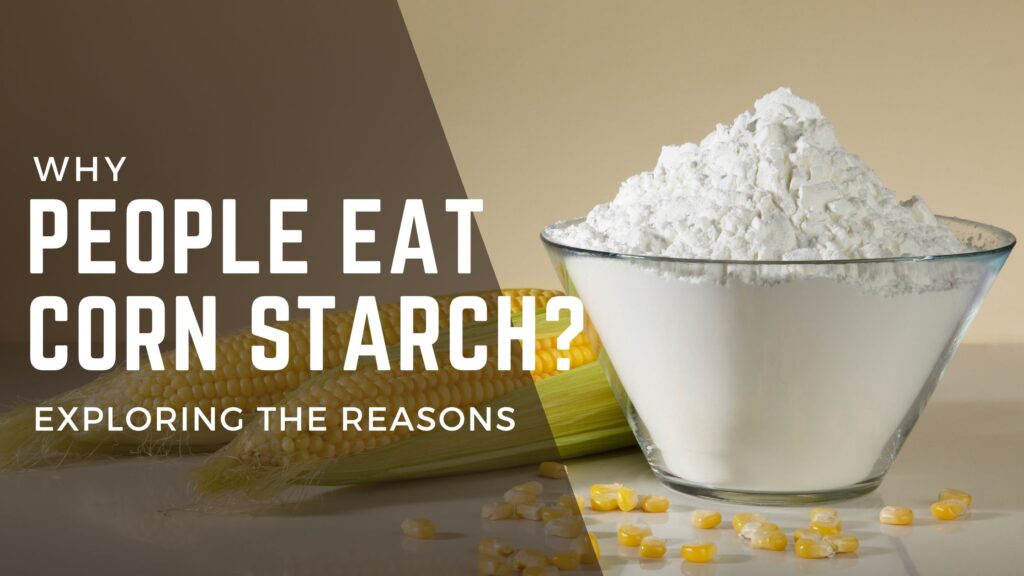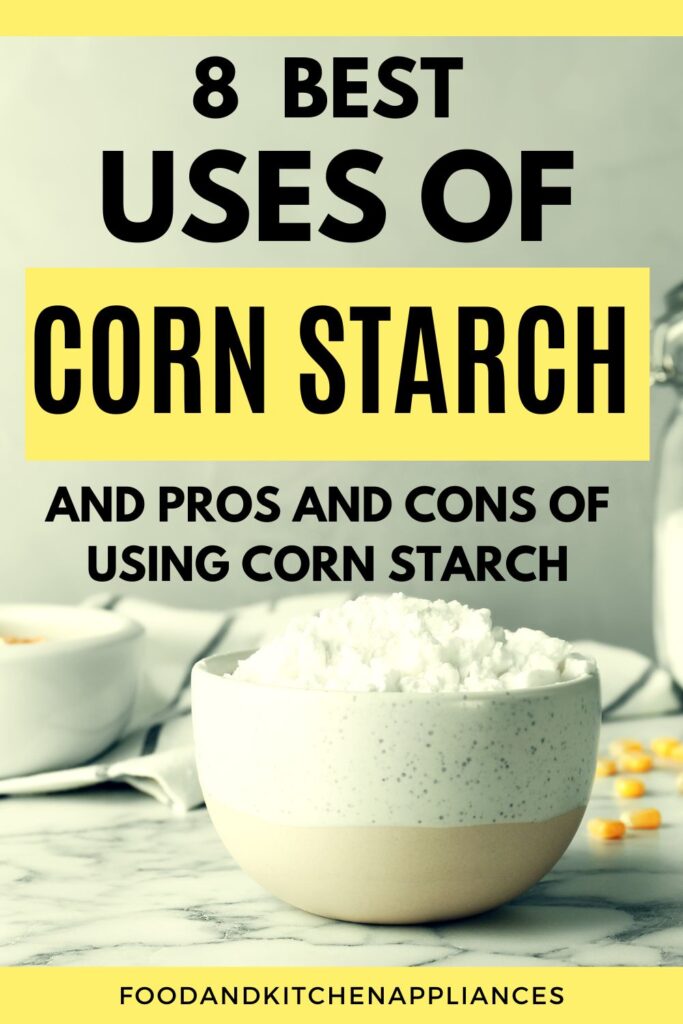People eat corn starch for various reasons, from cultural practices to medical conditions. Corn starch is a fine, powdery substance made from the starch of corn kernels. It is commonly used in cooking and baking as a thickening agent, but some individuals consume it as a food item.
Why do people eat cornstarch?
Some people eat corn starch due to cultural reasons. It is also used in many food preparations to make it thicker or for coating. One more reason why people might eat corn starch is due to a condition called pica. The consumption of non-food items, such as dirt, clay, and starches, characterizes Pica.
While the exact cause of pica is unknown, it is believed to be related to nutrient deficiencies or mental health disorders. Some individuals with pica crave the texture and taste of corn starch, leading them to consume it regularly.

History of Corn Starch Consumption
Corn starch is a versatile food ingredient that humans have consumed for centuries. The use of corn starch as a food additive can be traced back to the early 1800s in the United States when it was first used as a thickening agent in puddings, sauces, and soups.
As the use of corn starch as a food additive became more widespread, it was discovered that it could also be used as a binding agent in baked goods, such as bread and cakes. This led to an increase in demand for corn starch, and by the late 1800s, corn starch had become a common ingredient in many food products.
During World War II, corn starch consumption increased significantly due to its use as a substitute for wheat flour, which was in short supply.
In addition, cornstarch was used to make a variety of baked goods, including bread, cakes, and pastries, and it was also used as a thickening agent in soups and sauces.
Today, corn starch is still widely used in the food industry, and it can be found in various processed foods, including snack foods, cereal, and candy. It is also commonly used as a thickening agent in gravies, sauces, and soups, and it is also often used as a binding agent in gluten-free baked goods.
Nutritional Value of Corn Starch
Corn starch is a popular food ingredient commonly used as a recipe thickener. It is made from the starchy part of the corn kernel and is often used as a substitute for flour in gluten-free recipes. Corn starch is highly processed and is not a nutritional food item.
You should eat whole foods to get the nutrition, and don’t think that corn starch will add any nutrition to your food. It is used to give some texture to your dish.
One tablespoon (7 grams) of cornstarch contains:
- 30 calories
- 7 grams of carbohydrates
- 0 grams of protein
- 0 grams of fat
- 0 grams of fiber
- 0 grams of sugar
Corn starch is also low in calories and fat, making it a good option for those trying to lose or maintain a healthy weight.
However, it is essential to note that corn starch is a highly refined carbohydrate and should be consumed in moderation as part of a balanced diet.
Common Uses of Corn Starch in Cooking and Baking

Corn starch is a versatile ingredient commonly used in cooking and baking. It is a fine, white powder made from the endosperm of corn kernels. Here are some of the most common uses of cornstarch in the kitchen:
1. Thickening Agent
Corn starch is often a thickening agent in sauces, gravies, soups, and stews. When heated, the starch granules absorb liquid and swell, causing the mixture to thicken. Corn starch is beneficial for thickening acidic liquids like tomato sauce because it does not break down like other thickeners, such as flour.
2. Baking Ingredient
Corn starch is also commonly used in baking. It can make cakes, cookies, and other baked goods lighter and more tender.
It can reduce the gluten content when added to flour, resulting in a softer texture. Corn starch can also be used to thicken pie fillings, prevent ice crystals from forming in ice cream, and improve the surface of custards and puddings.
3. Coating for Frying
Corn starch is often used to coat fried foods like chicken or fish. The starch creates a crispy, golden-brown crust on the outside of the food.
It is beneficial for frying because it does not absorb as much oil as other coatings, such as flour or breadcrumbs.
4. Gluten-Free Alternative
Corn starch is a popular ingredient in gluten-free baking. It can be used as a substitute for wheat flour in many recipes, such as pancakes, waffles, and muffins, and also a common ingredient in gluten-free flour blends.
5. Glue and adhesives
Glue and adhesives are also made using corn starch due to their binding and thickening properties. It is even used as a biodegradable packing material to strengthen paper products.
6. Personal care
Corn starch can also be used in personal care products as a thickener, such as face masks or creams.
Due to its ability to absorb water and oils, corn starch is often included in these products to reduce their stickiness while providing an added sense of smoothness.
7. Laundry product
It is also used as a laundry starch, fabric stiffener, and even in some medical applications.
It can help reduce wrinkles and provide a professional finish to clothing, making them look freshly pressed. Additionally, it helps prevent the accumulation of static electricity on clothes.
8. Textiles
Corn starch can also be used in the textile industry. Its thickening and binding properties make it ideal for creating solid and durable fabrics and resisting shrinking or fading over time.
Potential Risks and Side Effects of Consuming Corn Starch
While corn starch is generally considered safe for consumption, some potential risks and side effects exist.
1. Digestive Issues: Consuming large amounts of corn starch can lead to digestive issues like bloating, gas, and diarrhea. It is a complex carbohydrate that can be difficult for some people to digest.
2. Blood Sugar Spikes: Corn starch is a high glycemic index food, which means it can cause a rapid increase in blood sugar levels. This can be problematic for people with diabetes or those at risk of developing diabetes.
3. Allergic Reactions: While rare, some people may be allergic to corn starch. Symptoms of an allergic reaction can include hives, swelling, and difficulty breathing. Anyone experiencing these symptoms after consuming corn starch should seek medical attention immediately.
4. Contamination: There is a risk of contamination with corn starch, particularly if it is not stored or prepared correctly. Contamination can lead to foodborne illness and other health problems.
While corn starch can be a helpful ingredient in cooking and baking, it is essential to consume it in moderation and be aware of potential risks or side effects.

Can eating raw cornstarch kill you?
No, eating raw cornstarch will not kill you. Overeating may cause digestive issues such as bloating and diarrhea, but it would not be life-threatening.
Cornstarch should only be eaten in small amounts and always cooked first to ensure it is safe for consumption. If you are unsure about the safety of any food, it is always best to consult your doctor before eating it.
Alternatives to Corn Starch
While corn starch is a famous thickening agent, some may prefer alternatives due to dietary restrictions, personal preferences, or other reasons. Here are some standard options for corn starch:
- Potato starch: Made from potatoes, this starch is gluten-free and has a neutral taste. It works well in soups, sauces, and gravies.
- Tapioca starch: Derived from the cassava root, this starch is also gluten-free and has a slightly sweet taste. It is often used in desserts and fruit fillings.
- Rice flour: Made from ground rice, this flour is gluten-free and can be used as a thickening agent instead of corn starch. It has a mild taste and can be used in sweet and savory dishes.
- Arrowroot starch: This starch is gluten-free from the arrowroot plant. It is neutral and works well in sauces, gravies, and puddings.
It’s important to note that each alternative may have different properties and require different amounts to achieve the desired thickness. It’s recommended to start with a small amount and gradually add more until the desired consistency is reached.
In addition to these alternatives, some people may also use xanthan gum, guar gum, or agar agar as thickening agents. However, these ingredients may not be as readily available as the abovementioned alternatives.
